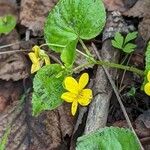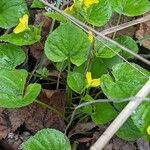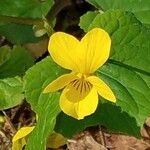Plants perennial, caulescent, not stoloniferous, 3–38 cm. Stems 1–3, erect or prostrate, leafless proximally, leafy distally, glabrous or finely puberulent, on caudex from fleshy rhizome. Leaves basal and cauline; basal: 0–4(–7); stipules ovate to obovate, margins entire, crenate, or serrate, usually glandular, apex acute to obtuse; petiole 7–27.5 cm, glabrous or puberulent; blade usually reniform to ovate, sometimes orbiculate, 3.3–8.5 × 2–9.3 cm, base cordate, margins crenate to serrate, ciliate or eciliate, apex acute to obtuse, mucronulate, surfaces glabrous or finely puberulent; cauline similar to basal except: usually restricted to distal ends of naked stems; stipules ovate to oblong, margins erose or subserrate, often glandular, apex acute to acuminate; petiole 0.2–2.9 cm, glabrous or finely puberulent; blade ovate to deltate, 1.4–5.7 × 0.8–4.7 cm, base cordate to truncate, margins crenate to ± serrate, ciliate (sometimes limited to proximal half), apex acute. Peduncles 2–8 cm, glabrous or pubescent. Flowers: sepals linear-lanceolate, margins eciliate, auricles 0.5–1 mm; petals deep lemon-yellow on both surfaces, lower 3 and sometimes upper 2 brownish purple-veined, lateral 2 bearded, lowest 6–18 mm, spur yellow to greenish, gibbous, 0.5–2 mm; style head bearded; cleistogamous flowers axillary. Capsules ovoid to ellipsoid, 7–13 mm, glabrous. Seeds light to dark brown, shiny, 2–2.2 mm. 2n = 24.
More
A small plant. It grows 10-30 cm high. It spreads 20-40 cm wide. The leaves are kidney shaped. They are slightly hairy. The leaves are broadly oval and pointed or kidney shaped. They are 25 mm long. The flowers are yellow with green tints. There are 5 petals. The fruit is a dry capsule with 3 valves. It has many seeds.
Can be grown by divisions or seedlings. Seeds needs stratification.





